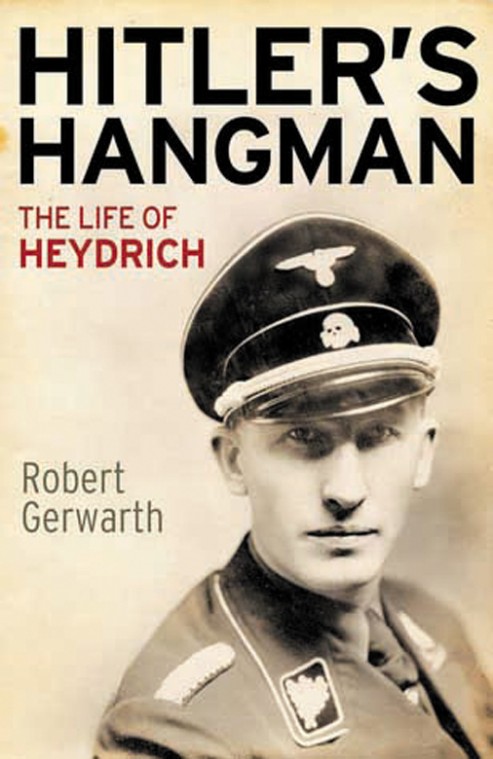Historian pens compelling biography of brutal Nazi mastermind
Published May 23, 2012
Except for his boss Heinrich Himmler, only Reinhard Heydrich — head of the SS security service and the Gestapo — was so instrumental in the planning and execution of the mass murder of six million European Jews, according to a historian Robert Gerwarth.
Professor of Modern History and Director of the Centre for War Studies at University College Dublin, Gerwarth traces the rise and demise of Heydrich —a man described as “ruthless, cold-blooded” and ambitious — in his latest book, “Hitler’s Hangman: The Life of Heydrich” (Yale University Press, $35).
The author was hampered by the lack of Heydrich’s personal papers, but through meticulous research in both American and European archives, Gerwarth clearly demonstrates how Heydrich’s attitude towards Jews progressed from exclusion to expulsion to extermination.
There was nothing in Heydrich’s early life that would be a precursor of his future activities. He was born into a middle-class Catholic family in 1904 in Halle, Westphalia. His father, Bruno, was a German opera composer and a director of a music school. Reinhard was raised in prosperity and was well educated. Like his father, he was an accomplished musician and an outstanding athlete. Unfortunately, the post World War I economic slump forced him to turn away from a musical career and he enlisted in the German navy.
Although most of his naval comrades were extremely nationalistic, Heydrich was not, and his fellow officers immediately began to ostracize him. His entire career in the navy was ignominious. In 1931 he was forced to face a military court of honor after the parents of a girlfriend complained that Heydrich had seduced her with a false promise of marriage. Heydrich not only refused to admit his guilt and offer an apology, he attempted to place the blame on the girl. The end result was that his superiors quietly “booted” him out of the navy.
Fortunately for Heydrich, his fiancée, Lina van Osten, was already a committed Nazi and anti-Semite at the age of 19. With the help of her parents and Heydrich’s godmother, Elise von Eberstein, whose son was a prominent storm trooper, Lina was able to obtain her fiancée a job in the SS security service. This not only brought Heydrich a salary during a time of mass unemployment, it also brought him into contact with Heinrich Himmler, the head of the SS, Hitler’s special bodyguard.
Gerwath maintains that prior to meeting Himmler, Heydrich had been apolitical. He became part of Hitler’s most extreme paramilitary group “not out of deep ideological conviction, but because Nazism offered him the opportunity to return to a structured life in uniform, and provided him with it a sense of purpose and a way of regaining the confidence of Lina and her family of devoted Nazis.” It did not take Heydrich long, however, to become one of Germany’s most zealous proponents of Nazi racial doctrine. One could correctly say that he became more Nazi than the Nazis themselves.
Before the war, Heydrich favored legal discrimination against the Jews, such as the Nuremberg laws of 1935, which made Jews second-class members of the state. With the help of his assistant, Adolph Eichmann, this legal discrimination of Jews was followed a few years later with wide spread emigration that combined intimidation and theft. Ultimately, Heydrich concluded that the war against Poland had added millions of Slavs and Jews to German territory without any possible way to be rid of them. This convinced Heydrich that physical extermination rather than resettlement or deportation was the only way to solve the “Jewish problem.”
In the autumn of 1941 Heydrich convened the infamous Wannsee Conference that met in January 1942 to organize the implementation of the Final Solution.
Heydrich did not live to see the consummate genocide carried out in full. Hitler appointed him Reich Protector of Bohemia and Moravia with the task of eliminating Czech resistance there. He began a systematic policy of racially defined divide and rule—using a quasi-Darwinian theory—Germanize “suitable” Czechs and deport or annihilate the remainder. The Czech government in exile arranged with the British to parachute agents into Prague to kill him. On May 27, 1942, Czech partisans ambushed his open-top car on his way to work and threw a bomb in. Heydrich died shortly afterward at the age of 38.
Gerwarth’s book is excellent. It is well written, well researched and thoroughly documented. While he presents a story that may be familiar to many, it is well worth reading again. This book is unique in that the author takes the reader inside the inner workings of the Third Reich, carefully exploring its evil bureaucracy.














